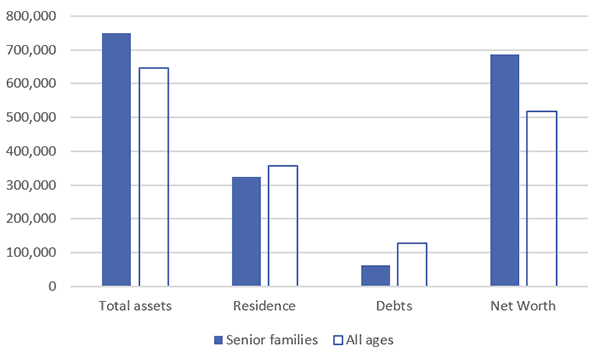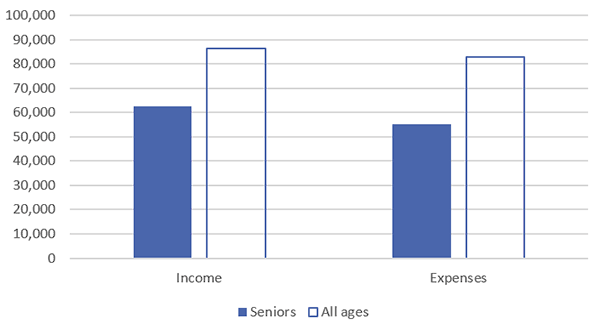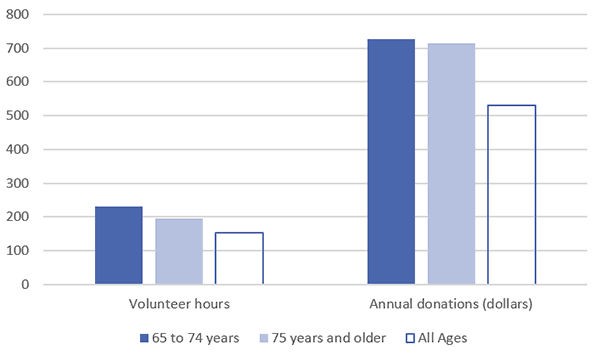When communities attract and retain older residents in a diverse population mix, they gain the economic benefits as well as the social strengths of a mature population.
The benefits of an age-friendly community range from accessible and affordable housing and services to an inclusive social structure with strong community connections. Without suitable housing and services for all, municipalities risk losing the social backbone of their communities, as well as the key financial resources that older residents control.
A diverse population also helps municipalities balance the demands for expensive services and amenities aimed at younger residents.
In economic terms, municipal governments that attract and support older residents in an age-friendly community can realize a higher return on their investments. Building a population with a diverse age mix is an investment, not a cost.
Here's why:
More assets, less debt
Older Canadians have more assets and less debt than the average population.
- Senior families, on average in 2012, owned total assets of $748,900, compared to $645,900 for all families.
- Senior families owned a residence with an average value of $324,700, compared to $356,200 for all families.
- Senior families had total debts of $61,700, compared to $129,000 for all families.
- Senior families had a net worth of $687,200, compared to $516,900 for all families.
These assets mean that senior families are able to contribute to their community, both by spending locally and by investing in local enterprises. They support the arts, cultural and service organizations, and many share their assets through donations to local organizations. Often, they support younger generations through gifts to family members.
Average Assets, Debts and Net Worth

| Senior Families | All Ages | |
|---|---|---|
| Total assets | $748,900 | $645,900 |
| Residence | $324,700 | $357,200 |
| Debts | $61,700 | $129,000 |
| Net worth | $687,200 | $516,900 |
Source: Statistics Canada Survey of Financial Security, 2012, total population and families whose eldest member was aged 65 or more1
Local income and spending
Older Canadians have significant income.
- Senior couples had an average family income of $65,540 in 2014, compared to $86,410 for all families. Although seniors’ average income is lower than average income for all ages, it remains significantly above Statistics Canada’s low-income measure for 2013 of $47,878.2 Senior households are able to contribute financially to the local economy through their spending on goods and hiring of paid services.
- Because on average about $30,000 of seniors’ family income comes from pensions and $26,000 from government transfers, it brings money into the community from external sources and expands the local economy, much like tourism spending does.3
Older Canadians spend significantly — and locally.
- Senior households spent on average $55,090 in 2014, compared to $82,697 for all Canadian households.
- Most of their spending is local, including household expenses, food, transportation, clothing, recreation and gifts. It supports local employment in retail and service businesses, from home repairs and renovations to travel agencies and golf courses. Through them, older residents contribute to the tax base of local municipalities.
Source: Statistics Canada, Family Characteristics, 2014, total population and families whose eldest member was aged 65 or more.4 Statistics Canada, Survey of Household Spending, 2015, total population and families whose eldest member was aged 65 or more.5
Research shows that older adults are consumers. They dominate 119 of 123 consumer categories for items such as food and beverages.6 They often have more disposable income than young people with families, and they spend it where they live.
Many older adults work, with 13.7% of adults over the age of 65 holding either full-time or part-time employment.7 Forty per cent of older workers choose self-employment.8 In doing so, they generate income for themselves and their community.
Older adults are more likely than younger residents to be entrepreneurs: seniors are twice as likely as millennials to plan to start a business and more than 80% of them begin ventures to boost income or as a lifestyle choice.9 With resources, experience and time, many older adults launch successful businesses, generating income and building the local economy.
Building community
Older Canadians contribute to their community.
- Canadians aged 65 to 74 contributed an average of 231 hours in volunteer time in 2013, and those aged 75 and over contributed an average of 196 hours, compared to 154 hours for all Canadians.
- Canadians aged 65 to 74 made donations averaging $715 in 2013, and those aged 75 and over made donations averaging $726, compared to $513 for all Canadians.
Source: Statistics Canada, General Social Survey: Giving, volunteering and participating, 2013, total population and families whose eldest member was aged 65 or more.10
Many older residents support their extended family as caregivers to younger generations. Older adults contribute more than four million hours in unpaid child care each week.11 Up to 35% of grandparents share their homes with children or grandchildren,12 and 22% help regularly with childcare and household support.13 This support strengthens social cohesion and allows younger family members to gain independence and join the local economy.
Seniors also contribute financially to support younger members of their families by helping with the purchase of a home or a car, wedding expenses, living expenses and education, or by giving money. They help younger generations deal with financial crises, such as the loss of a job or a disabling illness.14 Even seniors with a lower income often support their children and grandchildren.
Older residents help municipal governments maximize the use of community resources. They don’t require certain high-cost services such as schools and can contribute user fees for facilities such as pools and gyms. By using services such as roads, transit, commercial centres, athletic centres and other public facilities at off-peak times, they even out demand and improve usage rates.
Age-friendly communities are inherently diverse. When people at different life stages live side by side, collaboration between generations leads to a stronger, more vibrant community.
Housing options
Whether a community attracts new older residents or retains and supports those already there, an age-diverse population needs a range of housing options. Affordable, accessible housing in a variety of forms helps make a community attractive to all ages.
A range of housing options helps ensure that residents can age in place — that is, they can live in the same community safely, independently and comfortably as they age. As their needs change, it may mean the ability to adapt their existing home, rent an apartment or enter a facility that offers support services in their community.
A housing strategy for an age-friendly community
Municipalities can help make their community age-friendly and attractive to mature residents by creating a concrete, well-thought-out housing strategy and action plan for an age-diverse population. An appropriate strategy helps municipalities prepare for Canada’s coming demographic shifts, and lets them allocate resources to meet key needs on time. Creating a housing strategy allows planners and officials to work with allies, coordinate priorities, identify concerns and incorporate solutions before conflicts develop.
An age-friendly housing strategy also shows that the community is prepared. Developers, investors and residents will be more confident about their future in the municipality if they see concrete plans and preparations in place.
An appropriate housing strategy will help older residents continue to live rich lives in the municipality, with all the economic and social benefits that their presence brings.
Get resources and information today
Canada Mortgage and Housing Corporation provides resources and information for municipal officials and planners to create communities in which people can age in place.
- CMHC provides a variety of information resources on its Accessible and Adaptable Housing website pages, including specific publications on aging in place.
- The Public Health Agency of Canada’s resource page on Canada’s support for age-friendly programs, Age-Friendly Communities, includes background and links to programs supported by provincial governments.
- The Case for Age-Friendly Communities presents research on how improvements to address the needs of an aging population brings benefits to the whole community.
- CMHC provides statistics about seniors and senior-led households for many communities in Canada on its data webpage.
Footnotes
1 Statistics Canada, CANSIM, Table 205-0002, accessed March 20, 2017
2 Statistics Canada, Low income measures by income concept, for household size of four persons, 1976 – 2013, accessed March 29, 2017.
3 Statistics Canada, CANSIM, Table 206-0021, accessed March 20, 2017.
4 Statistics Canada, CANSIM, Table 111-0012, accessed March 20, 2017.
5 Statistics Canada, CANSIM, Table 203-0036, accessed March 20, 2017.
6 Neal, Margaret B., and Alan DeLaTorre, Grantmakers in Aging, The Case for Age-Friendly Communities, February 2016, page 11.
7 Statistics Canada, CANSIM Table 282-0002 11, Labour force survey estimates (LFS), by sex and detailed age group annual (persons x 1,000), accessed March 29, 2017.
8 Mei, Zhaowen, et al., Older Canadians Work In The Paid Labour Force, Page 2, accessed March 29, 2017
9 Neal, Margaret B., and Alan DeLaTorre, Grantmakers in Aging, The Case for Age-Friendly Communities, February 2016, page 9.
10 Statistics Canada, CANSIM, Tables 119-0001 and 119-0009, accessed March 20, 2017.
11 Mei, Zhaowen, et al., Older Canadians Provide Care, 2013, accessed March 29, 2017.
12 CARP, Seniors’ Contributions in Canada — Worth Celebrating, accessed March 29, 2017.
13 Mei, Zhaowen, et al., Older Canadians Provide Care, 2013, accessed March 29, 2017.
14 Mei, Zhaowen, et al., Gifts of a Lifetime: The Contributions of Older Canadians, 2013, accessed March 29, 2017.






 Share via Email
Share via Email


